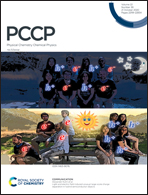The influence of diameter of multiwalled carbon nanotubes on mechanical, optical and electrical properties of Langmuir–Schaefer films†
Abstract
In this paper results of a study of mechanical, optical and electrical properties of thin films made of multiwall carbon nanotubes (MWCNT) of various types were reported. The MWCNT films were obtained on quartz substrates using the Langmuir–Schaefer (LS) method. A gradual increase in transmittance was recorded with decreasing diameters of MWCNT used. Moreover, a blue shift of the π-plasmon band position was observed with increasing MWCNT diameter. In all tested films, anisotropy of electrical surface resistivity was revealed, which was more pronounced for MWCNT of low diameters, except for the MWCNT sample of the smallest diameters. Results of oscillatory barrier measurements of various MWCNT films at the air water interface were used to calculate the complex compression and shear moduli. It is worth emphasizing that the values of these moduli were obtained for the first time for carbon nanotubes films. Moreover, the obtained results allowed identification of the main factor blocking the alignment process, which turned out to be the shear loss tangent.



 Please wait while we load your content...
Please wait while we load your content...